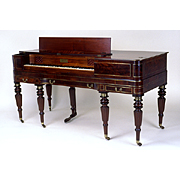| Maker(s): | Babcock, Alpheus
| | Culture: | American (1785-1842)
| | Title: | pianoforte
| | Date Made: | ca. 1826
| | Type: | Musical Instrument, Furniture
| | Materials: | woods: mahogany, mahogany and rosewood veneers, poplar, white pine, basswood, maple, ebony; ivory; base metal: brass; textile: silk; leather
| | Place Made: | United States; Massachusetts; Boston
| | Measurements: | overall: 33 9/16 x 67 1/2 x 26 9/16 in.
| | Accession Number: | HD 81.026
| | Credit Line: | Gift of Mr. William W. Newton
| | Museum Collection: | Historic Deerfield
|
|

|
Description:
Square pianoforte with a brass plate on the nameboard engraved: "MADE BY/A. Babcock,/for R. Mackay,/Boston" and stamped on the d1 key lever: "268". Inscribed in pencil is: "L. Babcock" on the action frame: "Hinsdale / NH" on the inside central drawer" and: "Hu[?]...Scholars/Josie Cheavor/Alice Cook/Ora Gibson/Etta.../Martha ... /Mary O'Brian [?]" on the inside left drawer, who were probably students in a Hinsdale schoool. Considered one of the most important piano makers of the early ninteenth century because of his fine workmanshiop and inventiveness, Alpheus Babcock (1785-1842) is best known for his development of a one-piece cast-iron frame, which he patented in Boston on December 17, 1825. Alpheus and his older bother, Lewis (1778-1814) apprenticed with Benjamin Crehore (1765-1831), New England's first piano maker, in their hometown of Milton, Massachusetts. First listed in business the 1810 Boston city directory, the Babcock brothers were joined in partnership by Thomas Appleton (1785-1872) as "Babcock, Appleton and Babcock" in 1812. After Lewis' death in 1814, Alpheus worked in other partnerships and businesses in Boston, and in Philadelphia from 1829 to 1837 where he worked for John G. Klemm; after returning to Boston in 1837, Alpheus worked for Jonas Chickering (1797-1853) until his death in 1842. Chickering had been in business with John Mackay (d. 1841) since 1830, and Alpheus supposedly returned to Boston at their request. Mackay was a Boston merchant and mariner whose family was known for its financial backing of Boston keyboard instrument makers, and who is credited for a patent (first issued in 1822, and reissued in 1839) for fitting metal into leather-covered hammerheads to produce a fuller tone. The piano has a rectangular case with rounded corners highlighted with dark mahogany, rosewood veneers and crossbanding, and brass stringing; a shallow, hinged lid and fall board which conceals an off-center keyboard with fretwork in a trellis pattern lined with red silk on each side of the maker's engraved brass plate on a light rosewood veneer; and three side-hung drawers with brass bail handles below. The case is supported by six heavy, turned, tapered legs with bold reeding and brass casters. One of the two foot pedals is missing. The keyboard has a FF-f4 compass, basswood key levers, ivory coverings, maple-molded key fronts and ebony accidental coverings.
Link to share this object record:
https://museums.fivecolleges.edu/detail.php?t=objects&type=ext&id_number=HD+81.026 |